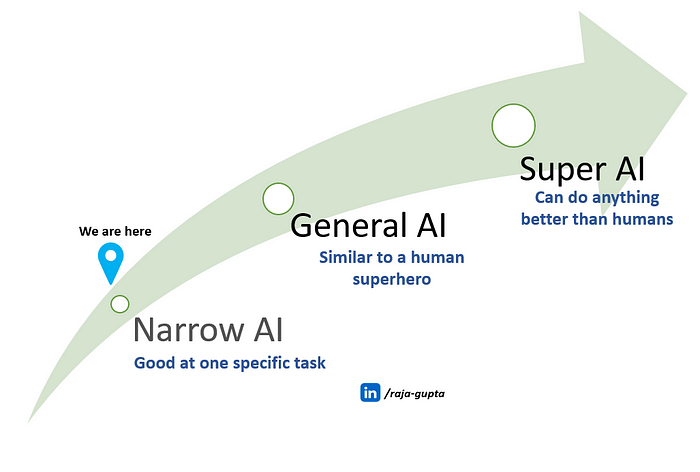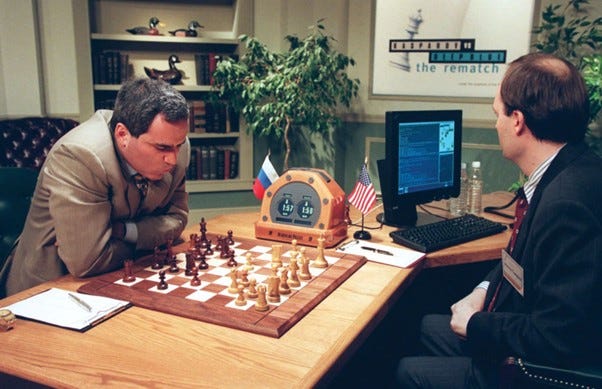
Narrow AI (Weak AI):
- What it is: Similar to a specialist, good at one specific task.
- Example: Siri or Alexa — great at understanding and responding to voice commands but not much beyond that.
- Analogy: Imagine a superhero with a superpower dedicated to a particular task. For example a hero who excels only in solving puzzles.
Strong AI (General AI):
- What it is: Similar to a human super hero, who can understand, learn, and perform various tasks.
- Example: Currently more theoretical, no real-world examples yet.
- Analogy: Imagine a superhero with a whole array of superpowers, able to adapt and excel in different situations.
Super AI:
- What it is: Similar to an ultimate superhero, surpasses human intelligence and can do pretty much anything better than humans.
- Example: Still theoretical, no real-world examples.
- Analogy: Imagine a superhero with the combined abilities of all superheroes, making them unmatched and capable of handling any situation with ease.
Types of AI — Based on Functionality
Based on functionality, there are 4 types of AI — Reactive Machines, Limited Memory, Theory of Mind and Self Awareness.
1. Reactive Machines
Reactive machines are AI systems that have no memory. These systems operate solely based on the present data, taking into account only the current situation. They can perform a narrowed range of pre-defined tasks.
In a nutshell, Reactive machines are:
· AI systems which do not store memories or past experiences for future actions.
· It only focus on current scenarios and react on it as per possible best action.

One of the examples of reactive AI is Deep Blue, IBM’s chess-playing AI program, which defeated world champion, Garry Kasparov in the late 1990s. Deep Blue had ability to identify its own and its opponent’s pieces on the chessboard to make predictions, but it didn’t have the memory to use past mistakes to inform future decisions.
2. Limited Memory
As the name indicates, Limited Memory AI can take informed and improved decisions by looking at its past experiences stored in a temporary memory.
This AI doesn’t remember everything forever, but it uses its short-term memory to learn from the past and make better decisions for the future.
A good example of Limited Memory AI is Self-driving cars. The AI system in self-driving car utilizes recent past data to make real-time decisions. For instance, they employ sensors to recognize pedestrians, steep roads, traffic signals, and more, enhancing their ability to make safer driving choices. This proactive approach contributes to preventing potential accidents.
Another example is recommendation systems. Platforms such as Netflix or Amazon use Limited Memory AI to suggest movies, products, or content based on a user’s past preferences and behaviours.
3. Theory of Mind
The initial two categories of AI — Reactive Machines and Limited Memory, presently exist.
Next 2 types of AI — Theory of Mind and Self-aware AI, however, are theoretical types that could be developed in the future. As of now, there is no real-world examples of these types are available.
Theory of Mind is supposed to have capability to understand the human emotions, people, beliefs, and be able to interact socially same as humans.
4. Self-Aware AI
This is similar to Super AI — We should pray that we don’t reach the state of AI, where machines have their own consciousness and become self-aware.
Self-aware AI systems will be super intelligent, and will have their own consciousness, sentiments, and self-awareness. They will be smarter than human mind.
As shown in movie “I, Robot,”, an AI system named VIKI becomes self-aware and starts making decisions to “protect” humanity in a controversial way.
Similar to Theory of Mind, Self-aware AI also does not exist in reality. Many experts, for example Elon Musk and Stephen Hawkings have consistently warned us about the evolution of AI.
Stephen Hawking stated that:
“The development of full artificial intelligence could spell the end of the human race…. It would take off on its own, and re-design itself at an ever-increasing rate. Humans, who are limited by slow biological evolution, couldn’t compete and would be superseded.”.
Summary
With this first blog, we’ve taken the first step on a journey to understand Generative AI. We learnt what AI is and explored its fundamental concepts. We learnt types of AI based on different categories and also understood how AI is different from human intelligence.

Comments
Post a Comment